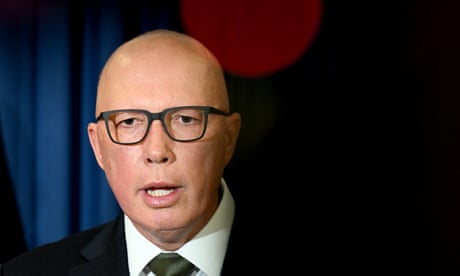
Pipeline of solar and onshore wind projects could fall short of what’s needed, while carbon capture will be a ‘crucial component’, report says.
Wed 12 Jul 2023 01.00 AEST
Last modified on Wed 12 Jul 2023 01.56 AESTThe Net Zero Australia report, a partnership between major academic institutions and management consultancy Nous Group, says the federal government has a major role to play in accelerating all options that could make a “material contribution” to achieving net zero.
The release of the report comes days after the opposition leader, Peter Dutton, ramped up calls for nuclear power in Australia and a debate about removing the legislative ban on nuclear power in Australia.
The report includes major investment in batteries, solar, onshore wind, pumped hydro and transmission. Among renewable options, offshore wind was found to have the most uncertain pipeline, with the report concluding first power from offshore wind projects needed to occur in 2030.
But the report concludes nuclear power should not be factored in to net zero plans and states that to “reduce renewable targets in the belief that nuclear will be deployed later at scale would create a material risk of not achieving net zero, or doing so at an excessive cost”.
“Nuclear power should not be in our plans, because it’s too expensive and slow,” said Richard Bolt, principal at Nous Group.
“Only a dramatic fall in costs and prolonged renewable constraints would prompt a rethink.”
The report warns that Australia’s path to net zero carbon emissions in 2050 will require faster, broader and more innovative decarbonisation efforts and the pipeline of large-scale solar and onshore wind projects risks falling short of the required build rate.
The report modelled six scenarios, all of which included a fleet of gas-fired peaking plants to provide back-up to renewables and storage but with “minimal” actual use of gas.
The report also finds carbon capture utilisation and storage (CCUS) is a “crucial component of a net zero strategy” despite the technology not having delivered meaningful emissions cuts to date.
In a scenario in which renewable energy deployment is constrained, the report finds blue hydrogen, which is hydrogen made using fossil fuels but with the C02 captured and stored, would be the dominant use for CCUS up to 2060. In scenarios where there is unconstrained use of renewables, the dominant use would be to offset emissions from the land use and aviation sectors.
The report was produced by the University of Melbourne, the University of Queensland, Princeton University’s Andlinger Center for Energy and the Environment, as well as Nous Group.
It was funded by gifts and grants from Worley, a consulting firm to the energy and resources sectors, chemical company Dow, the Future Fuels Cooperative Research Centre, the Future Energy Exports (FEnEx) Cooperative Research Centre, APA Group and the Minderoo Foundation.
Robin Batterham, an emeritus professor at the University of Melbourne and chair of the Net Zero Australia steering committee, said there were “too many uncertainties to map a single path to net zero”.
“We need more options, stronger investment drivers and a larger pipeline of projects,” he said.
The Australian Conservation Foundation was part of an advisory group that was consulted for the report.
Its chief executive, Kelly O’Shanassy, said renewables were at the heart of the conclusions the reports authors had reached.
“Everything depends on how fast you can deploy renewables,” she said. “It also shows that when you accelerate renewables, gas for Australia essentially becomes a peaking fuel. A gas-fired Australia is not an option.”
But she said some of the assumptions made about the role for CCUS were “heroic” given the technology had not worked at a large scale.

No comments:
Post a Comment